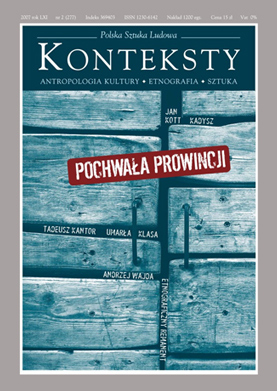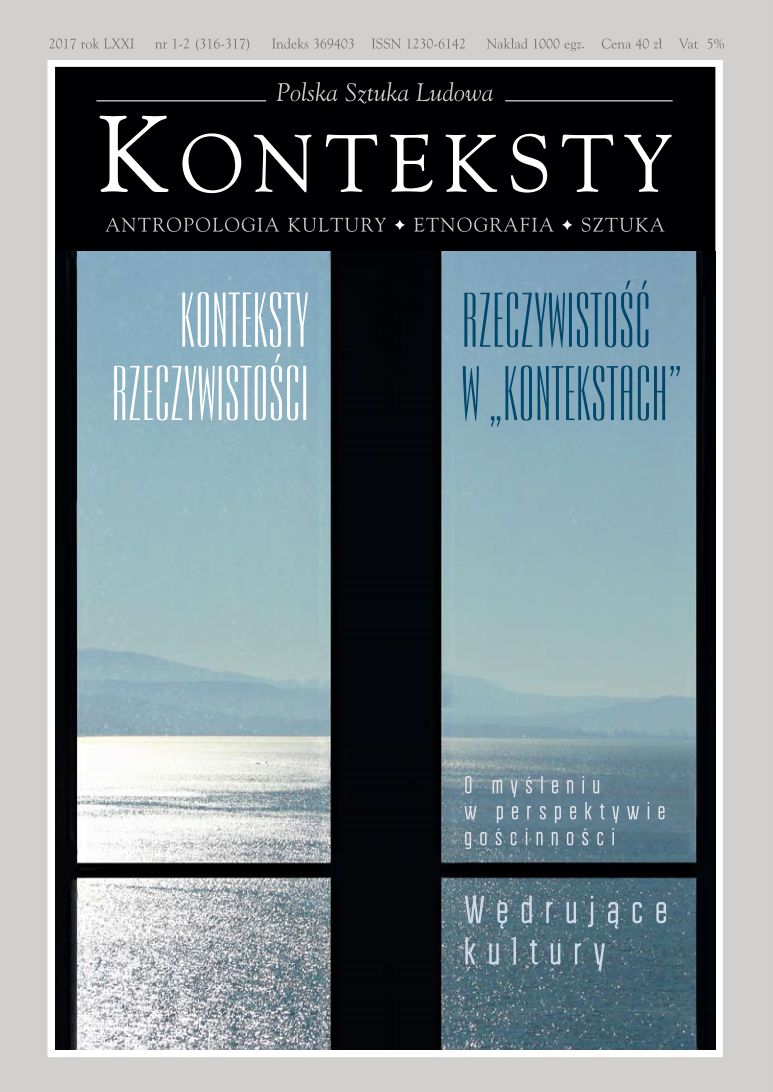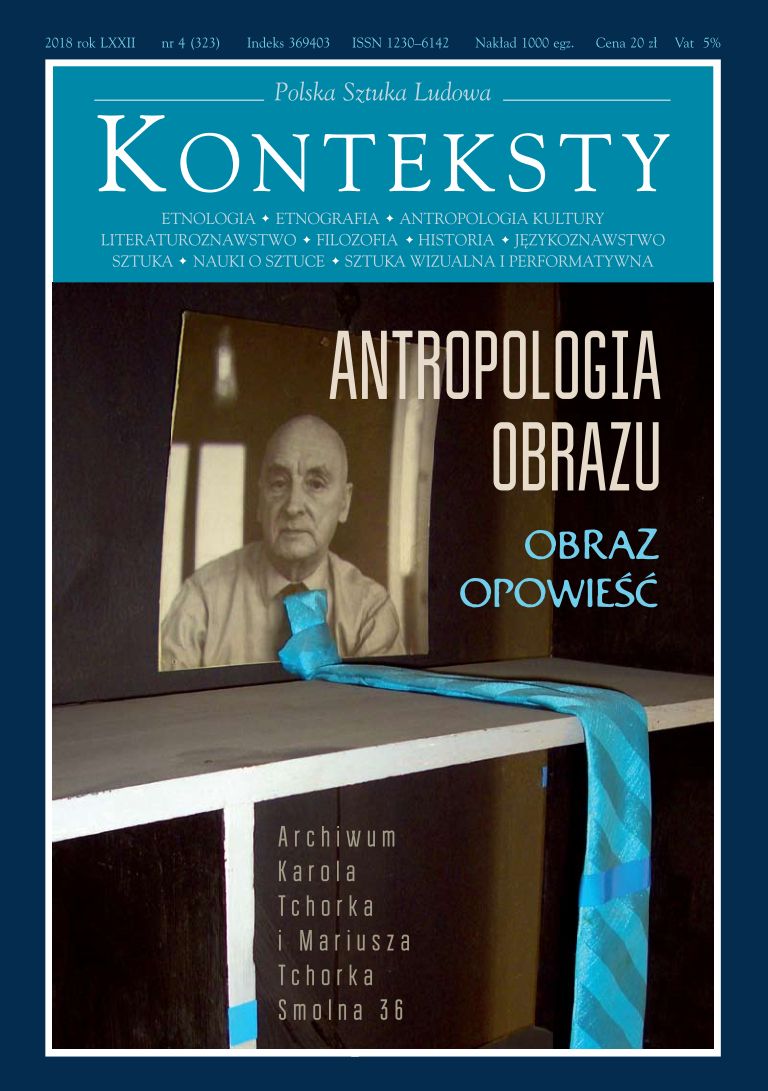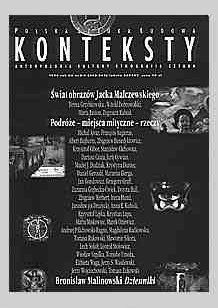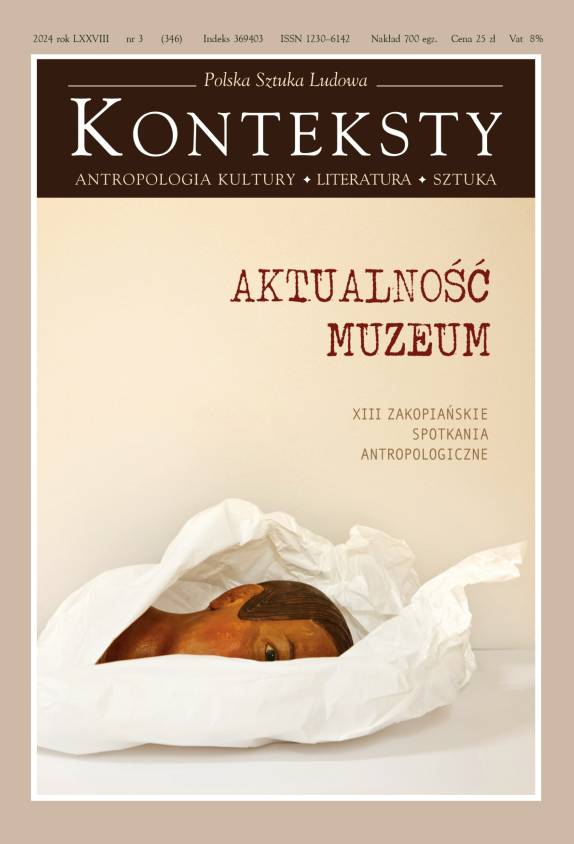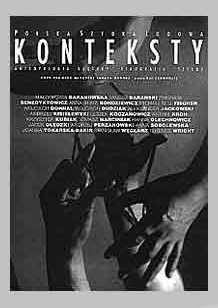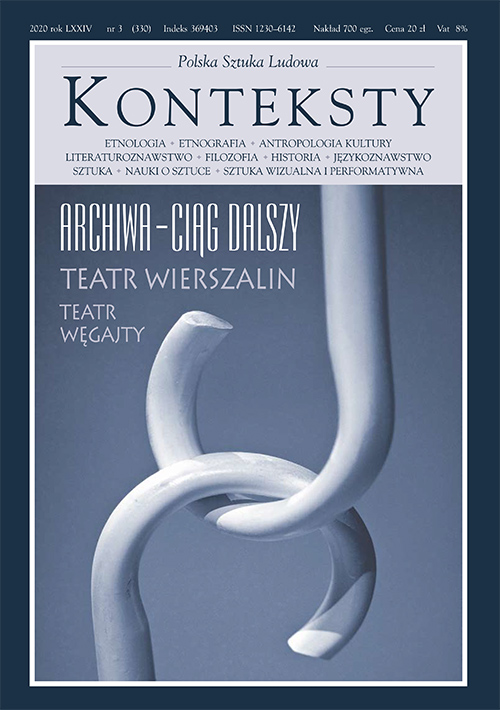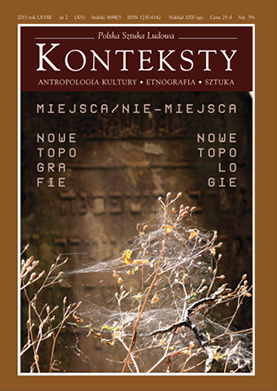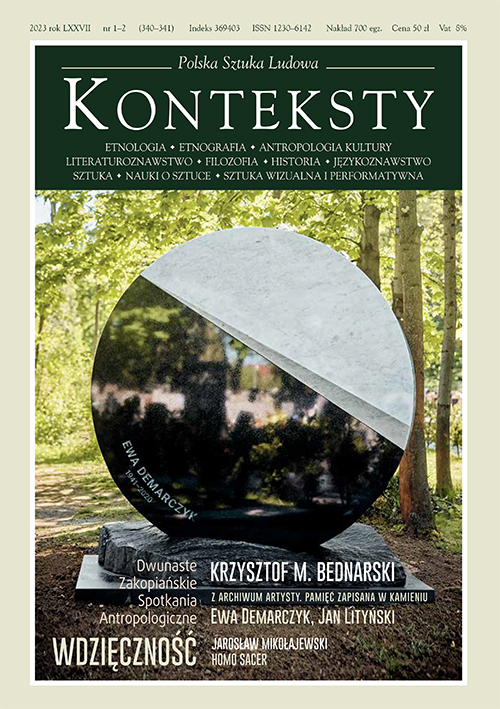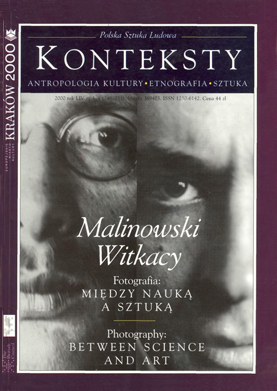Issue 2015/3 (310) -

| Agnieszka Karpowicz | Avant la lettre | 3 |
| * | Leopold Buczkowskis Short Biography and Bibliography | 5 |
| Dialogue | ||
| Justyna Staroń | Letters from Buczkowski  | 7 |
The article is composed of two parts, with the main one being an assortment of letters by Leopold Buczkowski to his wife, Maria; the selection criterion was the author’s voyages abroad. The edition is preceded by an introduction briefly discussing the contents of the remaining correspondence at the Adam Mickiewicz Museum of Literature in Warsaw. The letters served as a foundation for an outline of a history of the Buczkowskis. | ||
| * | What a Brilliant Man! Hanna KircherTalks with Agnieszka Karpowicz | 17 |
| Blending | ||
| Sławomir Buryła | The Holocaust Told Differently  | 25 |
The author presents the works of Leopold Buczkowski against the backdrop of Polish prose about the Holocaust, with special attention focused on Czarny potok, Buczkowski’s greatest novel. The sketch depicts the uniqueness of Buczkowski’s prose – Czarny potok is the only novel dating from the time of People’s Poland that shows Shoah by resorting to the technique of a radical literary experiment. | ||
| Ewelina Skłodowska | Conceptual Blending in Literature – a Way to Cope with Trauma? „La Route des Flandres” by Claude Simon and „Czarny potok” by Leopold Buczkowski  | 34 |
The article considers conceptual blending as a method for coping with trauma in literature. An examination of two novels: La Route des Flandres by Claude Simon and Czarny potok by Leopold Buczkowski was conducted by using the theory of blending mental spaces proposed by Gilles Fauconnier and Mark Turner. The article intends to show the connections between conceptual blending as a form of creativity and transposing the experiences of trauma and melancholy into narration. The author assumed that blending mental spaces, which in literature often reveals itself in chaos, the absence of linearity, deformations, and ambiguity, is an adequate and realistic form for expressing emotions associated with experiencing war. It could become a remedy for the “malady of the soul” and a type of therapy; furthermore, it creates new challenges for the reader by urging him to join the process of creating sense in a novel by supplementing it with his frame of reference. | ||
| Olga Kaczmarek | “Szabasowa”: Labyrinth of Margins  | 41 |
The author indicates the necessity of rereading Buczkowski’s Czarny potok within the context of contemporary debates about the Holocaust in Poland and wartime Polish-Jewish relations. That, which at present must comprise the object of a discussion and persuasion supported by scientific apparatus, is the brutality of the Holocaust, which in the so-called margins – provincial Poland – was witnessed by non-Jewish Poles and which for Buczkowski was a fresh wartime experience. It required not so much to be verified as rendered and evoked in a way that would bring such experience closer and not merely name and describe it. This is the objective of the novel’s difficult and impervious structure. | ||
| Territory | ||
| Radosław Sioma | “There is No Hatred”. A Portrayal of a Ukrainian in the ”Podolia Saga” by Leopold Buczkowski  | 46 |
A presentation of the Ukrainians in the early prose of Leopold Buczkowski, primarily his two novels: Wertepy (1947, written in 1937) and Czarny potok (1954). The pre-war image is much more diverse, both ethnically and as regards religion, while the post-war novel became, with few exceptions, a document of the activity of the Ukrainian Auxiliary Police involved in the Holocaust of the Jews and the Poles. | ||
| Arkadiusz Kalin | The Disciple of Faustus. Creative Links between Zygmunt Trziszka and Leopold Buczkowski  | 58 |
An ideological characteristic of relations between Zygmunt Trziszka and the author from Konstancin, established during the mid-1970s, the last period in Buczkowski’s life and oeuvre. From the very beginning these contacts assumed the form of a disciple-and-master relation owing to the age difference, literary rank, and admiration for the talent of the older author; in time, however, they turned into closeness and mutual creative transactions. Zygmunt Trziszka not only borrowed from Buczkowski’s experiences, but also tried to propagate the works of his teacher by consistently creating a literary biographical legend and acting as the spiritus movens of the last works of the author of Czarny potok from the 1980s. Consequently, Buczkowski, at the time suffering from a writer’s block, published three more books – mainly an untypical record of registered conversations with him. In this case Trziszka not only performed the role a “midwife” of the reminiscences, but was a sui generis partner in a (philosophical) dialogue as the books’ editor-co-author. At the same time, he broached this concept by developing the idea of his master’s ”novel-document”, and in this manner becoming the sole, up to this day, continuator of Buczkowski’s creative conceptions, a process that the author of this article tried to briefly characterise and assess. This is also an opportunity for supplementing the oeuvre of Trziszka, today almost entirely forgotten and recognised mainly as a representative of the rural current in Polish literature. | ||
| Łukasz Grajewski | Spaces of a Text. About „Oficer na nieszporach”  | 72 |
The article discusses Oficer na nieszporach, a novel by Leopold Buczkowski, published in 1975. The author based himself on the existing analyses of Buczkowski’s works by resorting to instruments offered by the narrativist philosophy of history ( primarily the Ankersmitian version), the spatial turn in literary studies, the William T. J. Mitchell typology of spatial forms, and the theory of chaos. Consequently, he distinguished three spaces: local, in which Przemyśl is conceived as a mental place, total (cultural) spacetime - a function of impossible historical narration patronised by the subject of the historian in spe, and the concrete space–territory of the Eastern front at the time of World War I, whose purpose is the destabilisation of the reader’s habits. Furthermore, the author examined Oficer... within the context of the third spatial form in literature and the theory of chaos, indicating the fractal structure of the novel and the attractorial-Escherian form of reading reconstructions. The conclusions drawn by author to a considerable measure confirm fundamental theses concerning Buczkowski’s poetics, albeit shifting the emphasis towards such issues as aesthetics, politics, memorativeness or epistemology. | ||
| Archive | ||
| Piotr Sadzik | To Derail Language, to Derail History. The Leopold Buczkowski “Anarchive”  | 86 |
The author attempted to outline the consequences of a diagnosis situated at the very foundations of the literary project proposed by Leopold Buczkowski, who regarded the Holocaust not as one of many historical catastrophes but as an Event that, first of all, challenges our language by undermining its ability to bear witness to extreme events. The Polish writer has no precursors in proposing such an interpretation of the problem, and the radicalism and astonishing aptness with which he formulated his opinions about “language after the Holocaust” are still without an analogy (although a suitable context is to be found ,predominantly, in the writings of Paul Celan). The heart of the matter, therefore, is not a presentation of the Holocaust (order of contestation) but presentation by means of the Holocaust (performative order). The disassembly of traditional, causal-effect logic is followed by the disassembly of the entire heretofore model of historical narration, which from that moment becomes infected with intermittent and ephemeral memory. In this manner, the key figure around which the Buczkowski project revolved was the ”archive” in which the Polish writer saw not only an institution collecting, conserving, and cataloguing historical artefacts but also a matrix of individual identity. Its task involves gathering literally everything that happened (together with the innumerable, and not exclusively human, perspectives with which it was perceived). Long before the narrativists the author of Czarny potok also formulated a thesis about the strictly textual character of history. The Buczkowski utopian ”anarchive” possesses, therefore, a huge critical and emancipatory value because it reveals history as not yet dominated by any arché authorities but as a real chaos of events that are discontinuous and not arranged in order. | ||
| Jerzy Franczak | “A Fortuitous Combination of Death and Cemeteries”. The Novel, the Archive, and the National Memory Site in Bełżec  | 98 |
The enigmatic title of this text was borrowed from Pierwsza świetność, a novel by Leopold Buczkowski (1966), who approached the theme of the Holocaust on his own terms and did not succumb to moral blackmail offering the aesthetics of concentration camp literature, according to which obligation towards the dead is translated into spare realism and linguistic simplicity. Instead of writing novels he decided to procure ”documents” and to compile literary “archives”. In doing so, Buczkowski understood that the category of “testimony” proves to be inadequate in reference to such places as the death camp in Bełżec. Apart from several statements we do not have at our disposal numerous accounts regarding the camp. Owing to the specificity of rapid extermination it is simply impossible to seek support in the figure of the “Muselmann” [an inmate suffering from starvation and dire exhaustion], crucial for reflections about Shoah. For almost 500 000 Jews Bełżec was not a “place” but a final stage of their last journey. The challenge tackled by Buczkowski, completely alone in his work, was undertaken by Andrzej Sołyga, Marcin Roszczyk, and Zdzisław Pidek, who designed a National Memory Site in the camp. Does anything link those artistic practices attempting to define anew the relation between the landscape, memory, and representation? | ||
| Agnieszka Karpowicz | “Iron Burns Human Flesh Together With That of Horses”. Experiment – Experience – Ethics  | 111 |
An attempt at indicating the precursory nature of the writings of Leopold Buczkowski vis a vis the perspectives and themes broached in the contemporary humanities within cultural “turns” towards objects, animals and, more generally, non-human and mute social actors (Bruno Latour). An analysis of stories from the volume: Młody poeta w zamku (1959) conducted in reference to Buczkowski’s other novels focuses on those motifs and serves as an argument in favour of the autobiographical (here, the category of “self-fiction” proved helpful), experience-oriented, and ethical meaning of the radical experiments conducted by the writer. | ||
| Arché | ||
| Łukasz Wróbel | “Hey, Valiant Rifle, Who Would Have Guessed What You Concealed Within”. About a Great Semiologist  | 123 |
This article about Pierwsza świetność by Leopold Buczkowski proposes the following thesis: certain elements traditionally situated within the presented world (such as a dewdrop, protocols, an archive, rifles) de facto function on more than a single structural level of a given work, outside the limits of the presented world. It is this mutual functionalisation of those elements that sets into motion the machinery of Pierwsza świetność. They are part of the novel’s reality, but, at the same time, they are factors constituting conditions for the possibility of the presented world, its ontology, plot configurations, and construction of the dramatis personae. | ||
| Mikołaj Gliński | Buczkowski’s „De Inventione”. Few Notes on „Kąpiele w Lucca”  | 132 |
Apart from an extraordinary diversity of literary matter, with which Kąpiele w Lucca, the novel by Leopold Buczkowski, abounds, its author frequently offered the reader conspicuous references to classical rhetoric, and especially its part known as inventio. The article follows this particular rhetorical trope by showing individual cases of rhetorical references and rhetorical theory as a whole, to which Buczkowski referred in Kąpiele… Classical rhetoric in the form of inventio, conceived as a theory of building statements and speaking about the world in general, proves to be an important interpretation context of the novel in which classical theory becomes contrasted with the collage-like manner in which the novel communicates. | ||
| Karol Stefańczyk | Unrecognisable Reality. On the Modernistic Character of Writings by Leopold Buczkowski  | 140 |
What place does Leopold Buczkowski hold in Polish twentieth-century literature? The author of the article formulated a thesis claiming that we are dealing with a writer who was part of Polish Modernism. Issues perturbing Buczkowski are of an epistemological nature and pertain to the possibility of becoming acquainted with reality, subjectivity, communication, and presentation. According to the author of Kąpiele w Lucca each of those questions finds itself in a state of a permanent crisis caused by the impact of arché, which determines reality. | ||
| Henryk Bereza – Notes | ||
| Henryk Bereza | Road  | 152 |
Henryk Bereza on Leopold Buczkowski – reprinted reviews. | ||
| Henryk Bereza | Beauty at a Time  | 153 |
Henryk Bereza on Leopold Buczkowski – reprinted reviews. | ||
| Henryk Bereza | Destruction  | 155 |
Henryk Bereza on Leopold Buczkowski – reprinted reviews. | ||
| Henryk Bereza | Slaughtered City  | 157 |
Henryk Bereza on Leopold Buczkowski – reprinted reviews. | ||
| Marian Pilot | HB, Briefly  | 159 |
“Henryk Bereza had a hard life, full of obstacles and anguish. A happy life” – this is the way in which the author (and one of the few friends, to cite his words) of recollections about Henryk Bereza ended his text. He described the beginnings of Bereza’s literary “school” or “stable”, his Warsaw patriotism (Bereza did not leave the Polish capital for years), his resignation from a university career for the sake of freedom and independence in searching for a writer’s path, and his rebellion and declaration of an “artistic revolution” ideally interlocked with the peasant current in Polish literature. All those features were the reason why Bereza became the target of numerous attacks launched by academic Polish philologists (some being his former fellow students) who after his death issued a declaration claiming that his literary output was devoid of all value and unworthy of publication. | ||
| Jerzy Pluta | Henryk Bereza: Artist Reader / Writer / Master / Oneirist  | 162 |
A collection of reminiscences and notes by Jerzy Pluta about Henryk Bereza, published in 1997-2006 in, i.a. the literary periodical “Przecinek”. | ||
| Paweł Orzeł | Questions about Deciphering Notesby Henryk Bereza  | 168 |
An attempt at bringing the reader closer to the idea of the diary kept by Henryk Bereza, one of the most outstanding Polish literary critics, from 1976 to his death. Particular fragments of the text concentrate on the form of the notes, their character, and language, as well as the changes they underwent in the course of years. The second part portrays the researcher and renders his reminiscences about Bereza as well as problems connected with working on the titular notes. | ||
| Henryk Bereza | Notes. 1981  | 173 |
Fragments of Henryk Bereza’s diary from 1981. | ||
| Religious Culture as the Context of Social Change. Podolia, Ukraine | ||
| Magdalena Zowczak | Religious Culture as the Context of Social Drama. Podolia, Ukraine  | 189 |
The scenery of the life of communities in the neighbouring villages of Murafa and Klekotyna, situated along the eastern border of Podolia, is dominated by well-preserved churches contributing to the permanence of the traditional forms of religious culture, providing a framework for social dramas transpiring in Podolia, and assisting in their interpretation. Faith remains the basic function of constructing identity. At present, local religious culture, which assumed shape under the impact of the Russian Orthodox and Catholic creeds and Judaism, is subjected to profound transformations due to the departure of the Jewish community in the 1990s and a change in the language of the sacrum – Roman Catholic catechises and liturgy – from Polish to Ukrainian. In its contemporary form the Polish language has become the tongue of alteration, and a prominent percentage of the inhabitants of this traditional but, at the same time, mobile community has obtained Karta Polaka (Pole’s Card, Polish Charter), which facilitates economic migration and studying in Poland. The religious culture of the Roman Catholics has become an arena of an unequal battle waged by two confronting styles of religious life, its expression and aesthetics, discernible in particular within language and music. Owing to the authority enjoyed by the clergy and the latter’s local provenance (the Murafa parish is renowned for numerous callings) the ensuing modernisation of religious culture, bringing it closer to the dominating current of popular culture, is exceptionally effective. Traditional eschatology, which has grown more important as a result of the exodus of the Jewish residents and the unrest caused by the Russian invasion of eastern Ukraine, has not succumbed to modernisation. In contrast to the modernisation of Catholicism, ordained from above, the religious culture of the Russian Orthodox population, less controlled and formalised, remains strongly enrooted in local tradition and its transformations are much slower. | ||
| Magdalena Zatorska | Christian-Jewish Relations in a Model of Antagonistic Tolerance: from a Religious Community to a Community of Memory  | 206 |
This article was written upon the basis of ethnographic field studies conducted in Ukraine in the Vinnyts’ka oblast (the locality of Sharhorod) and the Cherkessk oblast (the locality of Uman). Before the Second World War Sharhorod, Murafa, and Uman were populated by a large Jewish community. During the war the Jewish inhabitants of Uman were murdered by the Nazis, but in Sharhorod and Murafa the Jewish population survived. In all three localities the last 25 years brought essential changes of the social and national structure – an outcome of political transformations and the collapse of the Soviet Union. During the 1980s and 1990s the entire Jewish community of Sharhorod and Murafa emigrated for economic reasons, but Uman witnessed a revival of a Hassidic pilgrimage movement and the establishment of a local Hassidic community. These changes affected the space of the examined communities, which, in turn, became the reason for social tension. The article discusses two disputes concerning Christian sacral objects in territories connected with the Jewish heritage of the given locality. By comparing a controversy concerning the Calvary in Sharhorod and a conflict surrounding a cross placed in direct proximity of a tzaddik’s grave in Uman the author attempted to demonstrate functional similarity between a religious community and a community of memory. | ||
| Jacek Wajszczak | Photographing the Sacral  | 220 |
Collected reflections about the part played by a photographer in ethnographic field studies. Since from the very onset photography endeavours to find its still imprecisely defined place amidst the social sciences and the humanities the author - an ethnologist, but also a professional photographer - voiced his opinion in the pertinent discussion. | ||
| Marcin Skupiński | “Cherez nashe sielo ishla Bozha Matier”. Public Religion and Enchantment in Contemporary Ukraine. Villages of Murafa and Klekotyna, Vinnyts’ka Oblast  | 228 |
The article starts with an attempt at outlining the historical and cultural factors that, in the author’s opinion, affect the exceptional significance of religious institutions in the examined region. In Murafa religion is a public, and by no means a private issue both upon the level of institutions and that of the individual; moreover, it is strongly connected with identity and conversions are rare. The second part of the article focuses on explaining within this context the term: “the enchantment” of the world and on that, which is decisive for the different visions of the world harboured by the author’s interlocutors regardless of their declared creed or the way of perceiving the world to which the researcher is accustomed. The whole article also tries to undermine some of the well-worn theses proposed by the sociology of religion, speaking about the ”disenchantment of the world” as well as frequent descriptions of the religious situation in Ukraine via Western conceptions of secularisation and the ”free market of religious services”. | ||
| Maria Sokołowska | Tongue and Identity. The Catholic Community vis a vis Linguistic Changes in the Church  | 237 |
This study was conducted as part of the Religious Culture and Social Transformations. A Study of a Local Community laboratory under the supervision of Prof. Dr hab. Magdalena Zowczak. The text tries to understand transformations affecting the awareness of identity among the oldest generation of Roman Catholics in Murafa, faced with the replacement in the local church of the Polish language with Ukrainian. The first part of the article outlines the linguistic situation in Murafa together with its historical context. Next, the author delved into the specificity of the linguistic competence of the older generation of local Roman Catholics, comparing it with the skills of the younger generation and, simultaneously, drawing attention to the reasons for this difference, i.e. changes in everyday reality and needs. The text also closely follows the use of Polish and Ukrainian during liturgy. The altered proportions in this particular domain, dating back to the regaining of independence by Ukraine, encounter different reactions among the parishioners, presented upon the basis of the narrations of the author’s interlocutors (both a commentary and a depiction of their personal attitude to the changes) as well as their religious practices at home, with the latter becoming another sphere of choosing a given language. An essential role is played in this respect by the media, supplying a number of assorted possibilities for individually moulding a cohesive project of own identity in accordance with religious needs. The author also considered the local choir as an institution celebrating traditional cultural ideals, while discussing its activity as rituals expressing a meta-social commentary (in accordance with the term introduced by Geertz) and demonstrating high value as practices supporting identity. Finally, the article recalls the specificity of ”local” identity, essential for the duration of the community. | ||
| Jan Wawrzyniec Lech | Resounding Chaos. The Situation of Musical Liturgy Among the “Roman Catholics” of Murafa  | 244 |
A summary of confidential narrations by the inhabitants of the village of Murafa (Podolia). Narrations describing national and religious identity and expressing a longing for certain lucidly outlined aesthetic stands are embroiled in an unofficial debate, almost excluded from the official discourse. The space in which this conflict takes place is the interior of the Roman Catholic church in Murafa, with liturgical music as a sphere reflecting these narrations. The researcher conducting field studies is steered to the functioning of the conflict involving musical aesthetics by empirical moments of ritually co-experiencing a profound social game, a certain subliminal network of interpersonal interactions between groups and the individual, and between space and the sacrum. Following those interactions via condensed and detailed descriptions of the most expressive scenes of the aesthetic conflict make it possible to devise a typology of musical-religious experience in the Roman Catholic part of Murafa. | ||
| Katarzyna Kaczmarska | Narrations about the Pole’s Card and Its Impact upon the Identity of the Inhabitants of Murafa in the Vinnyts’ka OblastPodolia, Ukraine  | 252 |
In the local discourse conducted in Murafa Polish identity is inseparably connected with the Catholic creed. The source of Polish identification was predominantly religious tradition, with the Polish language conceived as the language of prayer. After the Karta Polaka (Pole’s Card, Polish Charter) act was passed in 2008 many residents of Murafa received the document in question. The author of the article analysed three general stands vis a vis Karta Polaka, strictly correlated with age and distinguishable among the Roman Catholic inhabitants of Murafa. Members of the older generation do not attach importance to the possession of the Charter nor connect it with an awareness of Polish identity. For representatives of the middle generation the document has considerable economic significance since it enables them to easily find seasonal employment in Poland. The young generation – under 25 years of age – represents a pragmatic attitude towards the Charter, which enables them to benefit from free-of-charge studies in Poland. | ||






